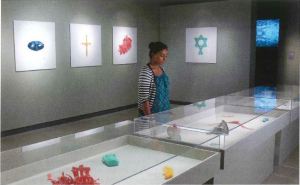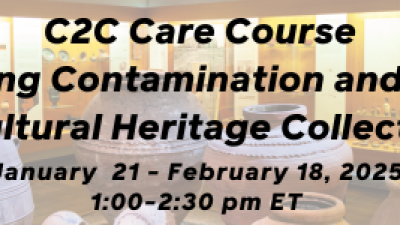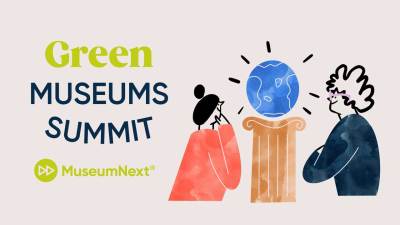
This article originally appeared in the July/August 2012 edition of the Museum magazine.
According to AAM’s Code of Ethics for Museums, the common mission of our institutions is their “unique contribution to the public by collecting, preserving and interpreting the things of this world.” How can museums parallel this cultural role by becoming leaders of environmental and sustainable stewardship? Choices that institutions make now will affect future generations locally and globally. It is important for museums to take a leading role in making green a new standard.
Changing how museums do business is a challenge. With a wide variety of institutional function, mission, and type, museums will find that sustainable practices are rarely “one size fits all.” All museums, however, can begin by considering, signing and committing to follow the tenets of the Green Museum Accord. Sparked by The Green Museums Initiative-an-effort of the California museum community to develop and implement sustainable practices, facilities, and programming—and the California Association of Museums, the accord is a non-binding, institution-wide pledge to begin or continue sustainable museum practices. It is the first initiative of its type. The accord states that “museums are integral to solving environmental challenges through their involvement in education, conservation, preservation, advocacy, and community-building. This happens through exhibits, programs, research, and partnerships, as well as through modeling sustainable practices.”
“Sustainability is not about getting it all perfect right away. It’s about working toward changing the way we do business….Smart small or start big: Just start.”

The five principles outlined are deliberately open-ended and designed to be attainable by all museums, regardless of their type, size or resources. For many museums, these measures are the first step towards making more environmentally responsible choices; for others they are an acknowledgement of the sustainable initiatives already in place and an incentive to continue and advance their good work. (Information is available at calmuseums.info/gmi/accord.)
As with any change, teamwork is usually more successful than individual efforts, so consider creating a “green team” with cross-departmental membership to lead the cause. Green teams have proven their effectiveness in Chicago’s “Museums in the Park,” a coalition of 10 museums located in the city’s Park District. One member, the Museum of Contemporary Art Chicago, has green teams whose wide range of successes include an institution-wide ban on disposable cups in favor of washable mugs and department-specific recommendations like having art frames
produced locally. Close by, the Shedd Aquarium transitioned from regular meetings of a green team to creating job descriptions that include the development of sustainability curricula and staff training. The aquarium has taken this a step further with the formation of a Sustainable Practices department that encourages other departments to maintain current sustainable practices and develop the new ones, such as recycling visitor wristbands. Even without any formal organization, your colleagues may already have undertaken green initiatives such as reusing materials in the exhibitions department. Thinking about your institution holistically can help you better support your mission now and in the future.
Many museums are already incorporating creativity, supporting their mission and integrating sustainability in their facilities and operations, food concessions, exhibition design, collections care, and building and historic preservation. The examples that follow demonstrate how you can apply sustainable practices to your life and institution.
Facilities And Operations
Taking care of your facility and re-evaluating current operations can save significant time and money. In its Whole Building Design Guide, the National Institute of Building Sciences states that sustainability can “conserve energy and water and be resource efficient while meeting the comfort, health, and safety requirements of the building occupants.” Museums constantly have backlogs or “unfunded/deferred maintenance” facility reports whose execution would cost thousands to millions of dollars. A major challenge is ever-changing and progressing technology. While one solution may be suitable for a design planned two years in advance, a “greener” alternative may become available in the interim. Looking at your institution’s processes and operations can help ensure the building is taken care of and allow you to fulfill your mission by keeping the doors open.
Museums in the planning and building stages are able to implement sustainable operations at the forefront. Such groundwork has been laid at the Peoria Riverfront Museum (PRM), set to open in October 2012 in central Illinois to more than 360,000 annual visitors. Through a “Green Tour,” visitors will learn how the museum earned Gold LEED-NC certification, the second highest green building certification given by the United States Green Building Council Leadership in Energy and Environmental Design-New Construction and Major Renovations. A walk outside demonstrates that the museum is built on a reclaimed abandoned site; native plantings decrease the amount of water required to maintain the landscape. Inside, energy-efficient bulbs are partially powered by solar panels, and visitors use low-flow water fixtures in the bathrooms.
Adding another dimension, the Strong National Museum of Play-a children’s museum in Rochester, N.Y.-uses such fixtures and practices to protect not only the environment but their young visitors. Here, non-toxic substances and materials become a major priority. No smoking is allowed inside or outside; wood with formaldehyde resin is in disfavor; the museum chooses either low- or no-VOC (volatile organic compound) sealants, paints and carpets; and only green-certified cleaning products are used.
At the Chicago Academy of Sciences and its Peggy Notebaert Nature Museum, the implementation of “green” cleaning techniques extends beyond the mere use of mild soap and water. The institution is also focusing on Integrated Pest Management (IPM), a method of preventing pest damage “with the least possible hazard to people, property and the environment,” according to the EPA’s website. Applying IPM practices has the beneficial side effect of promoting cleanliness through common-sense practices and without the use of harsh, conventional cleaning products. Steven Sullivan, senior curator of urban ecology, says that prevention methods include keeping floors vacuumed and the space beneath cabinets clean, and monitoring for pests with sticky traps. The museum uses rugs at doorways to trap dirt and avoids use of carpet elsewhere, keeping dirt to a minimum. “In carpet-less areas, cleaning is very green because we can simply sweep regularly and mop with a ro-per-cent bleach solution when necessary,” Sullivan says. In places like offices where there is likely to be both carpet and people eating at their desks, he advises, “make sure to communicate the dangers of pests and the simple ways to keep them from colonizing an area. In this way people are more likely to be careful with their food and trash.”
Simple solutions like walk-off mats at entrances decreases the amount of dirt tracked in by visitors, requiring less cleaning products and wear and tear to floor surfaces. According to a 2008 McMorrow Sustainability Facilities Management Report, in dry weather conditions, every 1,000 people bring in a quarter pound of dirt per day. Using a diluted bleach solution helps maintain clean internal air quality and safety, unlike the harmful chemicals found in many cleaning products. “By recruiting all of our staff to participate in being clean,” Sullivan says, “it is easier to be green.”
Food Concessions
Museums with food concessions-ranging from vending machines to food courts or full-service restaurants- will discover that the sustainable food industry is constantly developing. Major challenges include cost, visitor demand, and prioritization. When institutions outsource their food concessions, as many do, they immediately become part of the providing company’s sustainable goals (if any), which can vary. However, some institutions have made great strides on their own in setting the bar for sustainable food concessions, as well as consumer resources.
When food concessions are outsourced, it is a challenge to apply institutional sustainability policies to those of another company. The Green Restaurant Association (GRA). however, has made significant impact by certifying existing restaurants, buildings, and events. The Arctic Cafe (previously the Arctic Food Court) at the Detroit Zoological Society is the first zoo concession to be certified by the association, exceeding the minimum requirements in all categories. Sarah Popp, the zoo’s manager of environmental services, says, “Each day as consumers, we make decisions that will impact our environment. As the first zoo to have a green certified restaurant, we offer guests a greener alternative to traditional foodservice operations. We offer food options and services that reduce our environmental impact. This is important for the Detroit Zoo because it helps us to fulfill our mission [of] ‘Celebrating and Saving Wildlife.”‘
Two requirements for receiving GRA certification are a comprehensive recycling system and a ban on Styrofoam use. The Arctic Cafe earned points by using 100-percent recycled towels and napkins, bio-based disposable flatware and Compact Fluorescent Lamps (CFL) bulbs for 45 percent of the lighting. In addition, 21 percent of their total monthly purchases are vegan and 58 percent are vegetarian. Many believe that meat consumption is bad for the environment because livestock production, transportation, and waste produce harmful carbon and methane emissions. Globally, livestock production is linked to biodiversity degradation and deforestation. Furthermore, eating less meat could prevent obesity, a current epidemic in the U.S., as well as heart disease and various cancers.
In addition, institutions like California’s Monterey Bay Aquarium have implemented programs to conserve ocean life by encouraging the consumption of sustainable seafood. The aquarium’s “Seafood Watch” takes the forms of a mobile app and a wallet-sized pamphlet, informing consumers by region of fish that are “OK” to eat, meaning that they are abundant and healthful, not overfished or toxic. They also endorse”Fish2Fork,” which rates restaurants in terms of their sustainable fish offerings. By encouraging organizations to better their score, the GRA helps them implement new practices. Concession choices at your institution can be sustainable, influencing your staff’s and visitors’ personal decisions as well. In addition, institutions like California’s Monterey Bay Aquarium have implemented programs to conserve ocean life by encouraging the consumption of sustainable seafood. The aquarium’s “Seafood Watch” takes the forms of a mobile app and a wallet-sized pamphlet, informing consumers by region of fish that are “OK” to eat, meaning that they are abundant and healthful, not overfished or toxic. They also endorse”Fish2Fork,” which rates restaurants in terms of their sustainable fish offerings. By encouraging organizations to better their score, the GRA helps them implement new practices. Concession choices at your institution can be sustainable, influencing your staff’s and visitors’ personal decisions as well.
Exhibit Design
Exhibit design presents different challenges for promoting sustainability. Exhibitions can be permanent, temporary or traveling, with each form presenting its own difficulties. Cost and availability have typically driven material and design choices, yet the decision to incorporate green exhibition design has been mostly for environmentally themed exhibits or actual demonstrations of sustainable materials. Another challenge is the plethora of information and products that are labeled “green” by their manufacturers. Identifying products that are legitimately labeled as “green” will help prevent the phenomenon of “greenwashing,” in which products appear to be environmentally friendly but are not. To combat greenwashing, the EPA has created a green product Web portal at epa.gov/greenerproducts with additional resources for understanding “eco-labels” and product claims. The museum field has identified the need for a similar resource for exhibition design and fabrication due to their specialized needs and applications; greenexhibits.org is a leading resource for formulating sustainable exhibition design.
The Madison Children’s Museum’s website, greenexhibits.org-which provides extensive green exhibition design resources-explains that green exhibition design can encompass a range of approaches: “While some institutions may evaluate the impact materials have on environmental life cycles or make exhibits that contribute to regeneration of our environment, others may simply switch to paints that are less toxic as a starting point.”
The Office of Historic Alexandria (ORA) in the city of Alexandria, Va., boasts one example of sustainable exhibition design and fabrication. Here, eco-friendly roving “Mini-Museum” pushcarts were created to spark visitor curiosity and invite exploration of Alexandria’s centrally located historic and cultural small museums, which detail the city’s past as a thriving colonial seaport and home to George Washington and Robert E. Lee. ORA teamed with Paris Design to develop mobile displays that engage potential museum-goers right on the sidewalk, using sustainable design principles in all aspects of the project.
Exhibit elements embrace the Green Museum Accord principles of adaptation, reduction, reuse, recycling, and biodegradability. The large wheeled carts are made from wood, metal, and recycled canvas awnings. Exhibit display cases are unfinished pine and glass. The display carts are repurposed as activity centers in the ORA waterfront retail venue when not in use outdoors. Graphics are produced using environmentally responsible methods and products such as biodegradable substrates, thermal laminates, and eco-friendly inks. The pushcart display case panels and two-sided docent cards are made with recycled paper mounted to biodegradable substrate and laminated with biodegradable materials. Larger wall graphics that complement the pushcarts in the waterfront store use UV inks direct printed on biodegradable board. These biodegradable materials have the same durability as traditional display media. Unlike compostable plastics, no added resources are required for them to decompose safely in a landfill when discarded.
“Today’s sustainable technology can supplement inherent sustainable features without compromising unique historic character.”
While OHA incorporated sustainable exhibition design elements and materials into a specific exhibition concept, the UC Davis Design Museum combined exhibition practices with a sustainability theme. In the fall of 2011, the museum one of the founding adopters of the Green Museums Initiative-hosted the exhibition “Gyre, A Grand Tragedy of the Commons,” showcasing the work of artist Robert Gaylor. “Gyre” addressed the accumulation of plastic waste known as the “Great Pacific Garbage Patch” in the North Pacific Gyre (a giant, circular current on the ocean surface). The exhibit used predominantly recycled, eco-friendly materials. Embracing green practices and programming in both the exhibit topic and its use of media typifies the museum’s commitment to environmental concerns.
Collections Care
Many collections require tight environmental control to extend artifact lifespan, requiring significant energy use. Because collections vary museum to museum, resource consumption does as well. Botanical gardens and aquariums will have a higher consumption of water than a historical society, while many science museums and institutions with huge storage facilities consume more energy. Museums must pay attention to artifacts on display, as well as those being stored. Ensuring proper environmental conditions is a priority for these conservation measures. With such a wide range of needs and requirements, each museum’s collection care policy should be outlined in detail; any changes, green or not, should be evaluated by collections and conservation experts.
Energy is one of the most important and significant resources for museums. In 2009, Bradley Chase, program manager of the Cleveland Museum of Natural History’s GreenCityBlueLake Institute, blogged that electricity accounted for about 65 percent of its carbon footprint each year. Not surprisingly, successful new technology can help reduce not only our institutions’ carbon footprint but the bill.
According to Roger Chang, principal and director of sustainability at architectural firm Westlake Reed Leskosky, three areas of focus are transforming museum design: LED (Light Emitting Diode) lighting, desiccant dehumidification systems and building science research (the study of how and why buildings are constructed).
The U.S. Department of Energy’s Solid-State Lighting (SSL) Gateway Demonstrations has carefully tracked pilot usage of LED lighting in multiple facilities. In one example from this study, using LED lighting rather than halogens at the Smithsonian American Art Museum and its Renwick Gallery has reduced energy by an estimated 75 percent.
Desiccant dehumidification systems allow for the aggressive removal of moisture from air without the same demand on electricity and reheat energy use as conventional approaches. These systems use materials that can attract and hold more moisture, drying the air without cooling and using more energy.
Building science plays an increasing role in museum system design, both through computer simulation to optimize performance and through materials research to determine whether broader environmental control parameters can be adopted. While 70F+/-2F and 50%+/-5% RH is still considered a gold standard for environmental control in museums, these stringent settings are continually being reevaluated. The Indianapolis Museum of Art (IMA), for example, implemented new ranges of 70F +/- 4 and 50% RH+/-8 with small monthly seasonal adjustments “without adversely affecting the condition of collection objects and loans,” according to the IMA’s website, which tracks temperature and humidity via an online dashboard.
Chang notes that “museums benefit from the incredible level of research in many industries-all with the goal of using resources more efficiently-to allow collections and their institutions to sustain themselves for generations to come.”
Making changes to a museum’s lighting systems can affect not only energy use, but the stability of sensitive objects on display. Tim McNeil, associate professor in the Department of Design at the University of California, Davis, is searching for the most energy efficient, aesthetically pleasing and artifact-safe exhibition lighting in collaboration with the California Lighting Technology Center and university engineering and medical faculty.
Because of stringent conservation standards, McNeil believes, current lighting technologies don’t allow us to see many museum artifacts in their best light. “I’m convinced that new energy efficient technologies such as LEDs will allow us to increase light levels safely and vastly improve the visitor experience and an appreciation for the works on display, hence allowing for a whole new approach to museum interpretation,” he says. “Textiles, for instance, suffer enormously due to arcane light standards.” The lighting project is timely for his institution, as the state of California’s 2008 energy efficiency standards are expected to be amended in 2013 and go into effect Jan. r, 2014. California museums will be obligated to follow these.
Historic Preservation And Sustainability
Applying the principles of sustainability is relevant for all institutions, even historic sites. “Historic buildings were traditionally designed with many sustainable features that responded to climate and site,” explains the National Institute of Building Sciences’ Whole Building Design Guide. “Today’s sustainable technology can supplement inherent sustainable features without compromising unique historic character.” Unfortunately, there is little cohesion between green rating guides such as LEED and the Secretary of the Interior’s 1995 Standards for the Treatment of Historic Properties and similar guidelines from leaders such as the National Trust for Historic Preservation and the American Association for State and Local History. Cost and availability of original materials can also prove to be challenging. Nonetheless, many historic sites have been able to creatively and legitimately meet challenges presented by original infrastructure and mechanisms, Trust guidelines and building integrity.
At Philadelphia’s Wagner Free Institute of Science, Director Susan Glassman knows first-hand the difficulties and rewards of uniting preservation and sustainability. At the natural history museum—which is also a National Historic Landmark—”preservation is inherently green,” she says. The Wagner is successfully “taking advantage of its dual mission-free science education and historic preservation- and making them complementary,” Glassman says.
Glassman’s team began by making simple low-cost, high-impact changes while planning for larger-scale projects. The Wagner’.s site manager, Don Azuma, first expanded the recycling program; more than 60 percent of would-be trash is now recycled. He also replaced incandescent bulbs in the historic globe fixtures with LED or compact fluorescents. A 2009 furnace fire forced the museum to expedite a heating system renovation plan. Once a top-of-the-line heating system back in 1907, the Broomell Vapor system was no longer performing at optimal capacity because a series of incremental fixes over the years had compromised its efficiency. Instead of gutting the building to install new piping, the Wagner kept the existing pipes and radiators and installed four new boilers and controls. Restoring and renovating the historic heating system while upgrading to new energy-efficient technology was an environmentally friendly decision. The Wagner’s conservative estimates predict a savings of 87,000 pounds annually of carbon dioxide emissions, thanks to new boilers and energy-efficient technology. Via an online interface, boiler performance and control temperatures in newly created zones throughout the building can be monitored from any remote location. Other projects at the Wagner include an electrical system overhaul, new lighting, and a full roof restoration to increase insulation and the building’s envelope (the space between the outside and inside building environment).
• • •
You can play a significant role in initiating or supporting sustainable measures at your institution, no matter its size, budget or mission. Considering your institution holistically is key to successfully integrating environmental and sustainable practices. Individual organizations collectively across the United States and the world can work together, ensuring that being green is no longer an afterthought, but forethought.









Comments